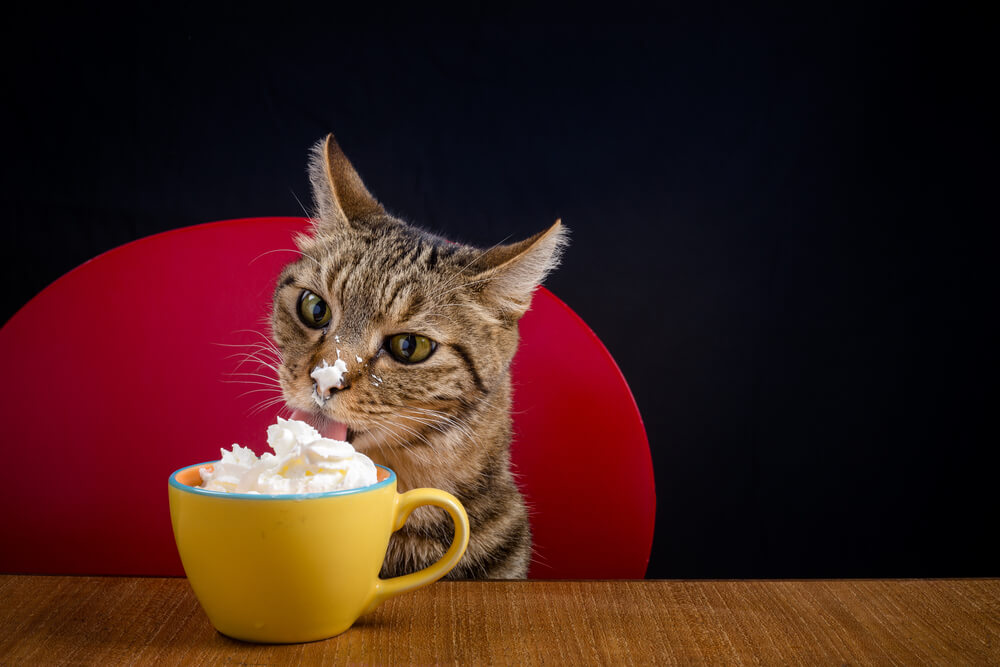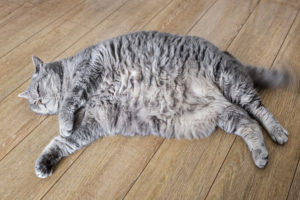Some cats are picky eaters, so it is difficult to say no to your feline friend when you find something they seem to love. However, if you have noticed that your cat loves dairy products like whipped cream, you might wonder if feeding it to him is safe.
Whipped cream is not toxic to cats but very unhealthy. Whipped cream can make your cat sick because most cats are lactose intolerant. Instead, give your cat fishy and meaty treats to be safe. If the cat ate whipped cream and shows severe dehydration or diarrhea, take your cat to the vet.
Most cats love whipped cream and other dairy products, but unfortunately, it is not a good idea for a treat.
Can A Cat Eat Whipped Cream?
Cats can eat whipped cream, but unfortunately, it is very unhealthy to feed it to your cat. Cats need a healthy amount of fat in their diet, and whipped cream contains harmful sugars. In addition, most cats are lactose intolerant, so they may develop issues when ingesting dairy products.
Just because cats seem to love milk, whipped cream, and ice cream does not mean you should give it to your cat.
Are There Benefits In Feeding Your Cat Whipped Cream?
There are no benefits to feeding whipped cream to your cat. It is not toxic, but it is very unhealthy. If you want to give your cat whipped cream and your cat is not lactose intolerant, make sure that you limit him to only a teaspoon per week. If you feed your cat more than this, he may develop health issues quickly.
Cats that eat whipped cream can develop nausea, diarrhea, and vomiting. If your cat seems able to digest whipped cream and other dairy products and you give it to him frequently, it is time to consider putting an end to it. These foods have no nutritional value for cats and can even lead to obesity, which has other serious consequences.
Feeding Whipped Cream To Your Cat Can Lead To Obesity
Feeding your cat too much whipped cream can cause an upset stomach, diarrhea, and vomiting. In addition, whipped cream is high in fat and can thus also cause obesity. Cats are primarily carnivores, so most of their food should consist of meat and fish, not dairy products like the cartoons would have you believe!
Symptoms Of Lactose Intolerance In Cats
Because they have little to no lactase enzymes, cats are lactose intolerant, and as such, their stomachs cannot digest dairy products like milk, yogurt, cream, ice cream, and cheese. As a result, kittens can only drink milk from their mothers or vet-approved powdered milk.
The sugars in these foods tend to draw bacteria, causing a severe upset stomach. If your cat consumes a lot of dairy, it can cause distress to its digestive system. According to Wag!, the following are symptoms of lactose intolerance:
- Excessive gas
- Abdominal pain
- Bloating
- Vomiting
- Diarrhea
- Constipation
- Polydipsia (increased thirst)
- Dehydration
- Increased heart rate
- Dry gums
If the symptoms become severe, you should visit a vet immediately, especially if your cat is dehydrated.
How To Treat Lactose Intolerance In Cats
The first step to prevent problems is completely cutting out all dairy products. If your cat has ingested a lot of whipped cream, seems to vomit a lot, and has severe diarrhea, your cat may become dehydrated. At this stage, your cat will need to visit a vet. The vet will perform a physical examination and test to see exactly how dehydrated your cat is.
Your vet will also perform blood work to check your cat’s overall health. If your cat is extremely dehydrated, your vet will administer intravenous and subcutaneous fluids. For the former, your cat will need to be hospitalized if he is severely dehydrated.
Your vet will administer subcutaneous fluids through a syringe into your cat’s loose skin. When at home, you must give your cat plenty of water during the day.
What Can You Feed Your Cat Instead Of Whipped Cream?
Instead of feeding your cat whipped cream, offer him healthy alternatives. Cats are meat eaters, so if you want to make your cat’s day give him some meat like cooked beef, turkey, chicken, or lean deli meat. Whole grains are also healthy for cats. Test whether your cat likes oats, corn, polenta, cornmeal, brown rice, wheat berries, couscous, millet, wholewheat breadcrumbs, or barley. Ensure that any grains you give are cooked, so your kitty can fully digest them.
Fish has a lot of omega-3, so it is healthy for your cat to consume. In addition, it can help with arthritis, kidney disease, and heart disorders. But make sure you do not feed your cat sushi, sashimi, or any raw fish.
Cooked eggs are also healthy for cats because they are high in protein. If you want to ensure your cat ingests a lot of vitamins, consider giving him vegetables like cucumber, cantaloupe, steamed broccoli, or asparagus.
You can even try to give your cat a veggie burger (no onions or garlic, though!). Some fruits like bananas, blueberries, seedless watermelons, and apples are also healthy for cats.
You can give your cat cheese once in a while, but most cats are lactose intolerant, so first, check whether your cat’s tummy can handle a small piece of cheese. If you’re too worried about your cat getting sick, it’s best to avoid it altogether.
What Are Cats Not Allowed To Eat?
Cats should not eat chocolate, grapes and raisins, onions, garlic, Macadamia nuts, bread dough, alcohol, or xylitol. These foods are toxic to cats and should not even be given as a rare snack. In addition, cats should always avoid caffeine, raw meat, and raw fish. If your cat ate any of these foods, take him to the vet for a check-up and inform him which foods your cat has eaten.
Cats should not have dairy products like whipped cream and milk. A small amount occasionally will not do any damage, though. But if your cat is lactose intolerant, steer away from dairy products like most cats.
- The first thing you must do if your dog or cat ate or were exposed to something that they should not have is to determine how much of the substance they actually ingested.
- Save labels or take pictures so that you are able to show the ingredients to your pet’s veterinarian.
- Your veterinarian should be the first point of contact in the case of such an event. Call the nearest emergency veterinary hospital if it is outside of normal business hours.
Please follow the advice of your veterinarian. If your dog has ingested something toxic, they must immediately be taken to a hospital or clinic for treatment. If your veterinarian does not recommend seeing your pet right away, you should observe them carefully for any signs of illness. Things to be on the lookout for include:
- Vomiting – Your dog may vomit from simple gastrointestinal distress after eating something other than their dog or cat food. However, intractable or repeated vomiting can signal a toxin ingestion or another serious issue like gastric dilation volvulus. These conditions are life threatening and require emergency treatment right away.
- Lethargy – If your dog is acting oddly, or “not themselves,” it is a clue that the ingestion might be serious. Veterinary care should be sought as soon as possible.
- Hypersalivation – Excessive drooling may signal a toxin exposure or an injury to the mouth. It can also be a sign of nausea. If your dog or cat is in hypersalivation, you should reach out to their veterinarian.
- Weakness – If your dog or cat appears to be weak, is stumbling, or has difficulty walking, the likelihood of a toxin ingestion is higher. This is a sign that your dog requires veterinary care.
- Seizures – Twitching, rapid leg or eye movements, and convulsions are all signs that something is wrong. These abnormal movements may be due to a toxin or another issue that the dog is experiencing.
- Dribbling urine – Leaking urine is often seen in cases of marijuana toxicity. Dogs or cats exhibiting this sign should be taken to the nearest veterinary clinic for treatment.
If you are unable to reach your veterinarian, a great resource for help is the ASPCA Animal Poison Control Center. The APCC is available 24 hours a day, 7 days a week. You can reach them at (888) 426-4435. There is a one-time $75 fee for this service.
Final Verdict
Most cats are lactose intolerant, so it is best to steer clear of whipped cream and other dairy products. If you give it occasionally, if your cat is not lactose intolerant, it won’t do any damage. However, if your cat becomes severely dehydrated and shows other symptoms like vomiting and diarrhea, you must take your cat to the vet.
Frequently Asked Questions
Additional Sources & Resources
- Cats and whipped cream: a review of the literature (https://www.ncbi.nlm.nih.gov/pmc/articles/PMC4967233/)
- Whipped Cream Inhalation in Cats (https://vcahospitals.com/know-your-pet/whipped-cream-inhalation-in-cats)
- Cats and Whipped Cream: A Systematic Review (https://www.researchgate.net/publication/321872760_Cats_and_Whipped_Cream_A_Systematic_Review)
- Dangers of Whip Cream for Cats (https://pets.webmd.com/cats/guide/dangers-of-whipping-cream-for-cats)
- Is it Safe to Feed My Cat Whipped Cream? (https://www.veterinarypartner.com/Content.plx?P=A&S=0&C=0&A=573)
Also check out our guide on whether cats can have cucumbers as well.


